Strategic Decision Making in Health: Analysis of Financial Issues
VerifiedAdded on 2022/10/15
|10
|3578
|28
Essay
AI Summary
This essay delves into the critical area of strategic decision-making within health management, focusing on financial issues as a primary concern. It begins by identifying the challenges of rising healthcare costs, including those related to pharmaceuticals, insurance, and overall healthcare expenditure. The essay then employs a multi-faceted approach to analyze the problem, utilizing four key frames of reference: human resources, structural elements, and political influences. The human resource framework examines how staffing, payroll, and patient billing affect financial outcomes and service quality. The structural framework investigates how organizational and environmental factors impact primary care delivery, including the roles of government and professional relations. The political framework explores the impact of regulations, compliance, and the influence of political dynamics on productivity and teamwork within healthcare settings. The essay concludes by offering potential solutions derived from the analysis, aiming to improve financial efficiency and the quality of healthcare delivery.

Strategic decision making in health
Secure Best Marks with AI Grader
Need help grading? Try our AI Grader for instant feedback on your assignments.
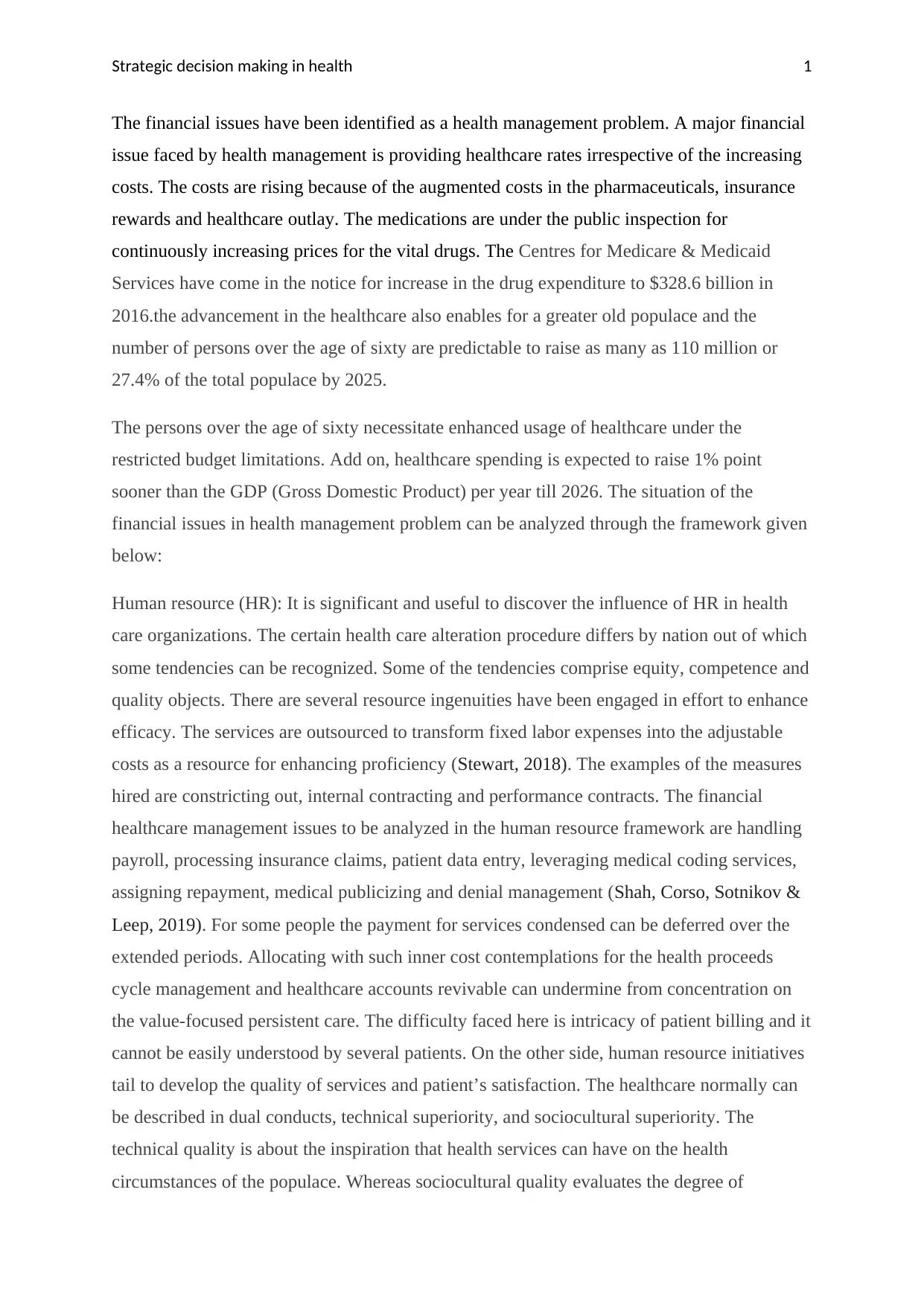
Strategic decision making in health 1
The financial issues have been identified as a health management problem. A major financial
issue faced by health management is providing healthcare rates irrespective of the increasing
costs. The costs are rising because of the augmented costs in the pharmaceuticals, insurance
rewards and healthcare outlay. The medications are under the public inspection for
continuously increasing prices for the vital drugs. The Centres for Medicare & Medicaid
Services have come in the notice for increase in the drug expenditure to $328.6 billion in
2016.the advancement in the healthcare also enables for a greater old populace and the
number of persons over the age of sixty are predictable to raise as many as 110 million or
27.4% of the total populace by 2025.
The persons over the age of sixty necessitate enhanced usage of healthcare under the
restricted budget limitations. Add on, healthcare spending is expected to raise 1% point
sooner than the GDP (Gross Domestic Product) per year till 2026. The situation of the
financial issues in health management problem can be analyzed through the framework given
below:
Human resource (HR): It is significant and useful to discover the influence of HR in health
care organizations. The certain health care alteration procedure differs by nation out of which
some tendencies can be recognized. Some of the tendencies comprise equity, competence and
quality objects. There are several resource ingenuities have been engaged in effort to enhance
efficacy. The services are outsourced to transform fixed labor expenses into the adjustable
costs as a resource for enhancing proficiency (Stewart, 2018). The examples of the measures
hired are constricting out, internal contracting and performance contracts. The financial
healthcare management issues to be analyzed in the human resource framework are handling
payroll, processing insurance claims, patient data entry, leveraging medical coding services,
assigning repayment, medical publicizing and denial management (Shah, Corso, Sotnikov &
Leep, 2019). For some people the payment for services condensed can be deferred over the
extended periods. Allocating with such inner cost contemplations for the health proceeds
cycle management and healthcare accounts revivable can undermine from concentration on
the value-focused persistent care. The difficulty faced here is intricacy of patient billing and it
cannot be easily understood by several patients. On the other side, human resource initiatives
tail to develop the quality of services and patient’s satisfaction. The healthcare normally can
be described in dual conducts, technical superiority, and sociocultural superiority. The
technical quality is about the inspiration that health services can have on the health
circumstances of the populace. Whereas sociocultural quality evaluates the degree of
The financial issues have been identified as a health management problem. A major financial
issue faced by health management is providing healthcare rates irrespective of the increasing
costs. The costs are rising because of the augmented costs in the pharmaceuticals, insurance
rewards and healthcare outlay. The medications are under the public inspection for
continuously increasing prices for the vital drugs. The Centres for Medicare & Medicaid
Services have come in the notice for increase in the drug expenditure to $328.6 billion in
2016.the advancement in the healthcare also enables for a greater old populace and the
number of persons over the age of sixty are predictable to raise as many as 110 million or
27.4% of the total populace by 2025.
The persons over the age of sixty necessitate enhanced usage of healthcare under the
restricted budget limitations. Add on, healthcare spending is expected to raise 1% point
sooner than the GDP (Gross Domestic Product) per year till 2026. The situation of the
financial issues in health management problem can be analyzed through the framework given
below:
Human resource (HR): It is significant and useful to discover the influence of HR in health
care organizations. The certain health care alteration procedure differs by nation out of which
some tendencies can be recognized. Some of the tendencies comprise equity, competence and
quality objects. There are several resource ingenuities have been engaged in effort to enhance
efficacy. The services are outsourced to transform fixed labor expenses into the adjustable
costs as a resource for enhancing proficiency (Stewart, 2018). The examples of the measures
hired are constricting out, internal contracting and performance contracts. The financial
healthcare management issues to be analyzed in the human resource framework are handling
payroll, processing insurance claims, patient data entry, leveraging medical coding services,
assigning repayment, medical publicizing and denial management (Shah, Corso, Sotnikov &
Leep, 2019). For some people the payment for services condensed can be deferred over the
extended periods. Allocating with such inner cost contemplations for the health proceeds
cycle management and healthcare accounts revivable can undermine from concentration on
the value-focused persistent care. The difficulty faced here is intricacy of patient billing and it
cannot be easily understood by several patients. On the other side, human resource initiatives
tail to develop the quality of services and patient’s satisfaction. The healthcare normally can
be described in dual conducts, technical superiority, and sociocultural superiority. The
technical quality is about the inspiration that health services can have on the health
circumstances of the populace. Whereas sociocultural quality evaluates the degree of
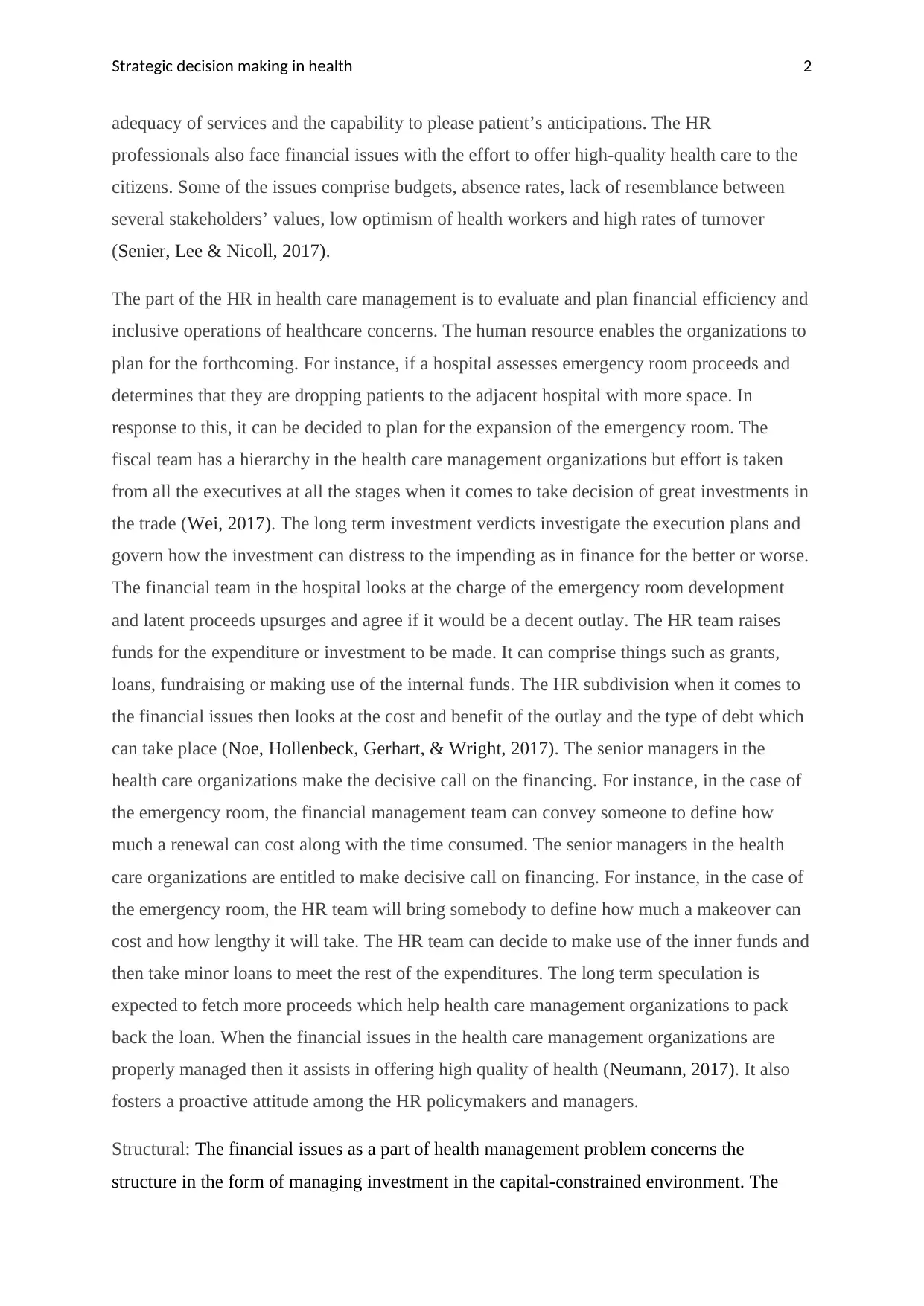
Strategic decision making in health 2
adequacy of services and the capability to please patient’s anticipations. The HR
professionals also face financial issues with the effort to offer high-quality health care to the
citizens. Some of the issues comprise budgets, absence rates, lack of resemblance between
several stakeholders’ values, low optimism of health workers and high rates of turnover
(Senier, Lee & Nicoll, 2017).
The part of the HR in health care management is to evaluate and plan financial efficiency and
inclusive operations of healthcare concerns. The human resource enables the organizations to
plan for the forthcoming. For instance, if a hospital assesses emergency room proceeds and
determines that they are dropping patients to the adjacent hospital with more space. In
response to this, it can be decided to plan for the expansion of the emergency room. The
fiscal team has a hierarchy in the health care management organizations but effort is taken
from all the executives at all the stages when it comes to take decision of great investments in
the trade (Wei, 2017). The long term investment verdicts investigate the execution plans and
govern how the investment can distress to the impending as in finance for the better or worse.
The financial team in the hospital looks at the charge of the emergency room development
and latent proceeds upsurges and agree if it would be a decent outlay. The HR team raises
funds for the expenditure or investment to be made. It can comprise things such as grants,
loans, fundraising or making use of the internal funds. The HR subdivision when it comes to
the financial issues then looks at the cost and benefit of the outlay and the type of debt which
can take place (Noe, Hollenbeck, Gerhart, & Wright, 2017). The senior managers in the
health care organizations make the decisive call on the financing. For instance, in the case of
the emergency room, the financial management team can convey someone to define how
much a renewal can cost along with the time consumed. The senior managers in the health
care organizations are entitled to make decisive call on financing. For instance, in the case of
the emergency room, the HR team will bring somebody to define how much a makeover can
cost and how lengthy it will take. The HR team can decide to make use of the inner funds and
then take minor loans to meet the rest of the expenditures. The long term speculation is
expected to fetch more proceeds which help health care management organizations to pack
back the loan. When the financial issues in the health care management organizations are
properly managed then it assists in offering high quality of health (Neumann, 2017). It also
fosters a proactive attitude among the HR policymakers and managers.
Structural: The financial issues as a part of health management problem concerns the
structure in the form of managing investment in the capital-constrained environment. The
adequacy of services and the capability to please patient’s anticipations. The HR
professionals also face financial issues with the effort to offer high-quality health care to the
citizens. Some of the issues comprise budgets, absence rates, lack of resemblance between
several stakeholders’ values, low optimism of health workers and high rates of turnover
(Senier, Lee & Nicoll, 2017).
The part of the HR in health care management is to evaluate and plan financial efficiency and
inclusive operations of healthcare concerns. The human resource enables the organizations to
plan for the forthcoming. For instance, if a hospital assesses emergency room proceeds and
determines that they are dropping patients to the adjacent hospital with more space. In
response to this, it can be decided to plan for the expansion of the emergency room. The
fiscal team has a hierarchy in the health care management organizations but effort is taken
from all the executives at all the stages when it comes to take decision of great investments in
the trade (Wei, 2017). The long term investment verdicts investigate the execution plans and
govern how the investment can distress to the impending as in finance for the better or worse.
The financial team in the hospital looks at the charge of the emergency room development
and latent proceeds upsurges and agree if it would be a decent outlay. The HR team raises
funds for the expenditure or investment to be made. It can comprise things such as grants,
loans, fundraising or making use of the internal funds. The HR subdivision when it comes to
the financial issues then looks at the cost and benefit of the outlay and the type of debt which
can take place (Noe, Hollenbeck, Gerhart, & Wright, 2017). The senior managers in the
health care organizations make the decisive call on the financing. For instance, in the case of
the emergency room, the financial management team can convey someone to define how
much a renewal can cost along with the time consumed. The senior managers in the health
care organizations are entitled to make decisive call on financing. For instance, in the case of
the emergency room, the HR team will bring somebody to define how much a makeover can
cost and how lengthy it will take. The HR team can decide to make use of the inner funds and
then take minor loans to meet the rest of the expenditures. The long term speculation is
expected to fetch more proceeds which help health care management organizations to pack
back the loan. When the financial issues in the health care management organizations are
properly managed then it assists in offering high quality of health (Neumann, 2017). It also
fosters a proactive attitude among the HR policymakers and managers.
Structural: The financial issues as a part of health management problem concerns the
structure in the form of managing investment in the capital-constrained environment. The
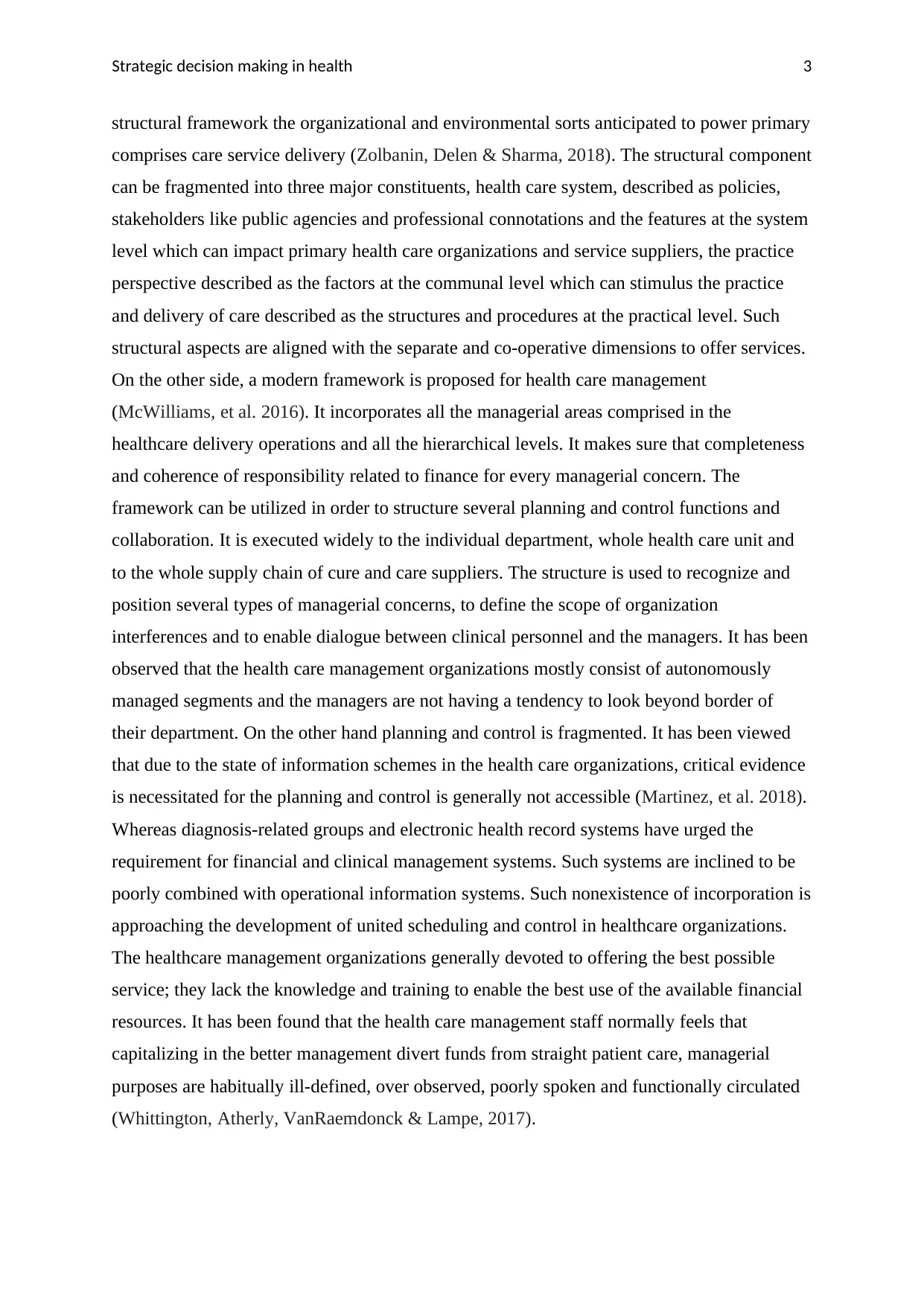
Strategic decision making in health 3
structural framework the organizational and environmental sorts anticipated to power primary
comprises care service delivery (Zolbanin, Delen & Sharma, 2018). The structural component
can be fragmented into three major constituents, health care system, described as policies,
stakeholders like public agencies and professional connotations and the features at the system
level which can impact primary health care organizations and service suppliers, the practice
perspective described as the factors at the communal level which can stimulus the practice
and delivery of care described as the structures and procedures at the practical level. Such
structural aspects are aligned with the separate and co-operative dimensions to offer services.
On the other side, a modern framework is proposed for health care management
(McWilliams, et al. 2016). It incorporates all the managerial areas comprised in the
healthcare delivery operations and all the hierarchical levels. It makes sure that completeness
and coherence of responsibility related to finance for every managerial concern. The
framework can be utilized in order to structure several planning and control functions and
collaboration. It is executed widely to the individual department, whole health care unit and
to the whole supply chain of cure and care suppliers. The structure is used to recognize and
position several types of managerial concerns, to define the scope of organization
interferences and to enable dialogue between clinical personnel and the managers. It has been
observed that the health care management organizations mostly consist of autonomously
managed segments and the managers are not having a tendency to look beyond border of
their department. On the other hand planning and control is fragmented. It has been viewed
that due to the state of information schemes in the health care organizations, critical evidence
is necessitated for the planning and control is generally not accessible (Martinez, et al. 2018).
Whereas diagnosis-related groups and electronic health record systems have urged the
requirement for financial and clinical management systems. Such systems are inclined to be
poorly combined with operational information systems. Such nonexistence of incorporation is
approaching the development of united scheduling and control in healthcare organizations.
The healthcare management organizations generally devoted to offering the best possible
service; they lack the knowledge and training to enable the best use of the available financial
resources. It has been found that the health care management staff normally feels that
capitalizing in the better management divert funds from straight patient care, managerial
purposes are habitually ill-defined, over observed, poorly spoken and functionally circulated
(Whittington, Atherly, VanRaemdonck & Lampe, 2017).
structural framework the organizational and environmental sorts anticipated to power primary
comprises care service delivery (Zolbanin, Delen & Sharma, 2018). The structural component
can be fragmented into three major constituents, health care system, described as policies,
stakeholders like public agencies and professional connotations and the features at the system
level which can impact primary health care organizations and service suppliers, the practice
perspective described as the factors at the communal level which can stimulus the practice
and delivery of care described as the structures and procedures at the practical level. Such
structural aspects are aligned with the separate and co-operative dimensions to offer services.
On the other side, a modern framework is proposed for health care management
(McWilliams, et al. 2016). It incorporates all the managerial areas comprised in the
healthcare delivery operations and all the hierarchical levels. It makes sure that completeness
and coherence of responsibility related to finance for every managerial concern. The
framework can be utilized in order to structure several planning and control functions and
collaboration. It is executed widely to the individual department, whole health care unit and
to the whole supply chain of cure and care suppliers. The structure is used to recognize and
position several types of managerial concerns, to define the scope of organization
interferences and to enable dialogue between clinical personnel and the managers. It has been
observed that the health care management organizations mostly consist of autonomously
managed segments and the managers are not having a tendency to look beyond border of
their department. On the other hand planning and control is fragmented. It has been viewed
that due to the state of information schemes in the health care organizations, critical evidence
is necessitated for the planning and control is generally not accessible (Martinez, et al. 2018).
Whereas diagnosis-related groups and electronic health record systems have urged the
requirement for financial and clinical management systems. Such systems are inclined to be
poorly combined with operational information systems. Such nonexistence of incorporation is
approaching the development of united scheduling and control in healthcare organizations.
The healthcare management organizations generally devoted to offering the best possible
service; they lack the knowledge and training to enable the best use of the available financial
resources. It has been found that the health care management staff normally feels that
capitalizing in the better management divert funds from straight patient care, managerial
purposes are habitually ill-defined, over observed, poorly spoken and functionally circulated
(Whittington, Atherly, VanRaemdonck & Lampe, 2017).
Secure Best Marks with AI Grader
Need help grading? Try our AI Grader for instant feedback on your assignments.
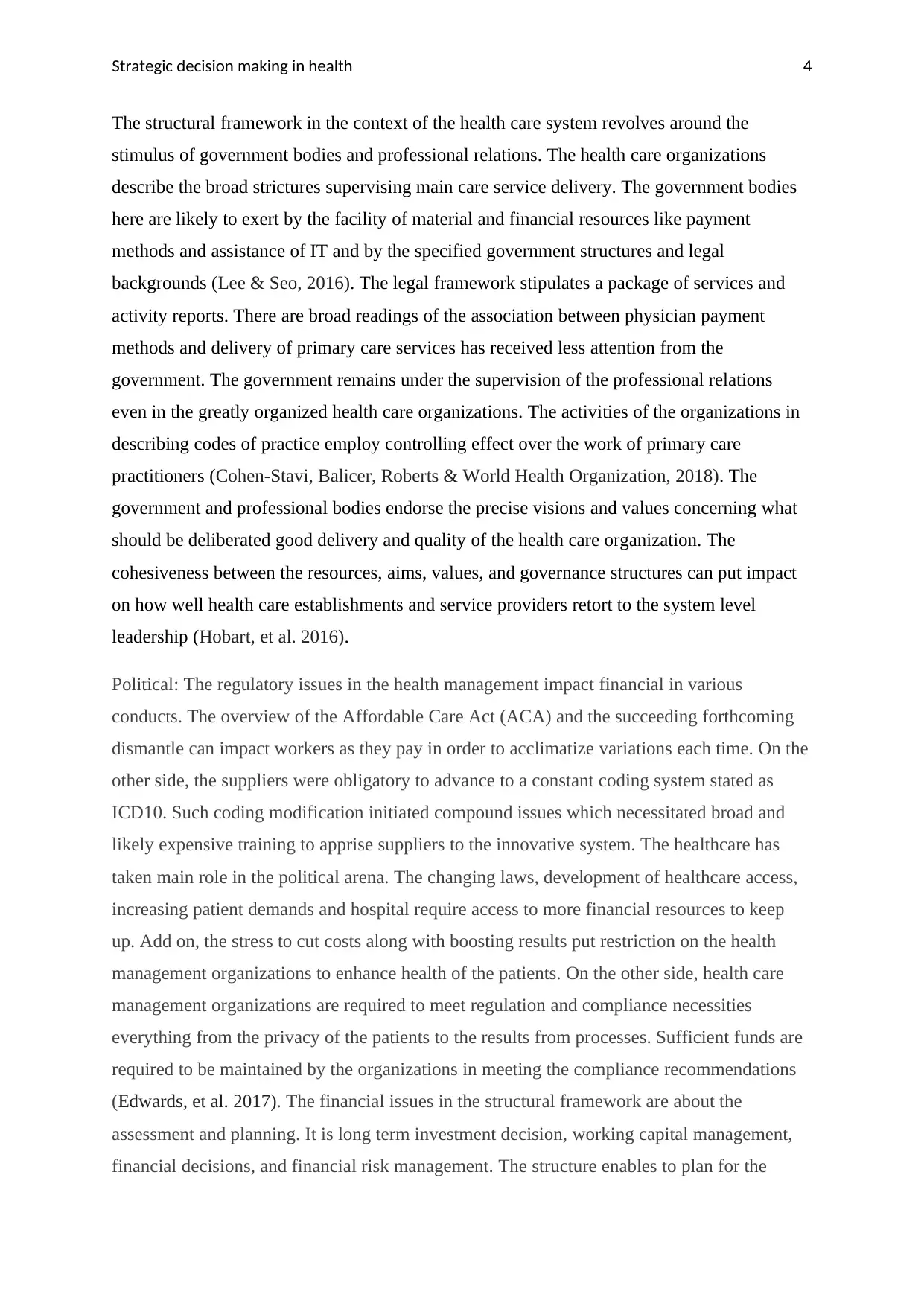
Strategic decision making in health 4
The structural framework in the context of the health care system revolves around the
stimulus of government bodies and professional relations. The health care organizations
describe the broad strictures supervising main care service delivery. The government bodies
here are likely to exert by the facility of material and financial resources like payment
methods and assistance of IT and by the specified government structures and legal
backgrounds (Lee & Seo, 2016). The legal framework stipulates a package of services and
activity reports. There are broad readings of the association between physician payment
methods and delivery of primary care services has received less attention from the
government. The government remains under the supervision of the professional relations
even in the greatly organized health care organizations. The activities of the organizations in
describing codes of practice employ controlling effect over the work of primary care
practitioners (Cohen-Stavi, Balicer, Roberts & World Health Organization, 2018). The
government and professional bodies endorse the precise visions and values concerning what
should be deliberated good delivery and quality of the health care organization. The
cohesiveness between the resources, aims, values, and governance structures can put impact
on how well health care establishments and service providers retort to the system level
leadership (Hobart, et al. 2016).
Political: The regulatory issues in the health management impact financial in various
conducts. The overview of the Affordable Care Act (ACA) and the succeeding forthcoming
dismantle can impact workers as they pay in order to acclimatize variations each time. On the
other side, the suppliers were obligatory to advance to a constant coding system stated as
ICD10. Such coding modification initiated compound issues which necessitated broad and
likely expensive training to apprise suppliers to the innovative system. The healthcare has
taken main role in the political arena. The changing laws, development of healthcare access,
increasing patient demands and hospital require access to more financial resources to keep
up. Add on, the stress to cut costs along with boosting results put restriction on the health
management organizations to enhance health of the patients. On the other side, health care
management organizations are required to meet regulation and compliance necessities
everything from the privacy of the patients to the results from processes. Sufficient funds are
required to be maintained by the organizations in meeting the compliance recommendations
(Edwards, et al. 2017). The financial issues in the structural framework are about the
assessment and planning. It is long term investment decision, working capital management,
financial decisions, and financial risk management. The structure enables to plan for the
The structural framework in the context of the health care system revolves around the
stimulus of government bodies and professional relations. The health care organizations
describe the broad strictures supervising main care service delivery. The government bodies
here are likely to exert by the facility of material and financial resources like payment
methods and assistance of IT and by the specified government structures and legal
backgrounds (Lee & Seo, 2016). The legal framework stipulates a package of services and
activity reports. There are broad readings of the association between physician payment
methods and delivery of primary care services has received less attention from the
government. The government remains under the supervision of the professional relations
even in the greatly organized health care organizations. The activities of the organizations in
describing codes of practice employ controlling effect over the work of primary care
practitioners (Cohen-Stavi, Balicer, Roberts & World Health Organization, 2018). The
government and professional bodies endorse the precise visions and values concerning what
should be deliberated good delivery and quality of the health care organization. The
cohesiveness between the resources, aims, values, and governance structures can put impact
on how well health care establishments and service providers retort to the system level
leadership (Hobart, et al. 2016).
Political: The regulatory issues in the health management impact financial in various
conducts. The overview of the Affordable Care Act (ACA) and the succeeding forthcoming
dismantle can impact workers as they pay in order to acclimatize variations each time. On the
other side, the suppliers were obligatory to advance to a constant coding system stated as
ICD10. Such coding modification initiated compound issues which necessitated broad and
likely expensive training to apprise suppliers to the innovative system. The healthcare has
taken main role in the political arena. The changing laws, development of healthcare access,
increasing patient demands and hospital require access to more financial resources to keep
up. Add on, the stress to cut costs along with boosting results put restriction on the health
management organizations to enhance health of the patients. On the other side, health care
management organizations are required to meet regulation and compliance necessities
everything from the privacy of the patients to the results from processes. Sufficient funds are
required to be maintained by the organizations in meeting the compliance recommendations
(Edwards, et al. 2017). The financial issues in the structural framework are about the
assessment and planning. It is long term investment decision, working capital management,
financial decisions, and financial risk management. The structure enables to plan for the
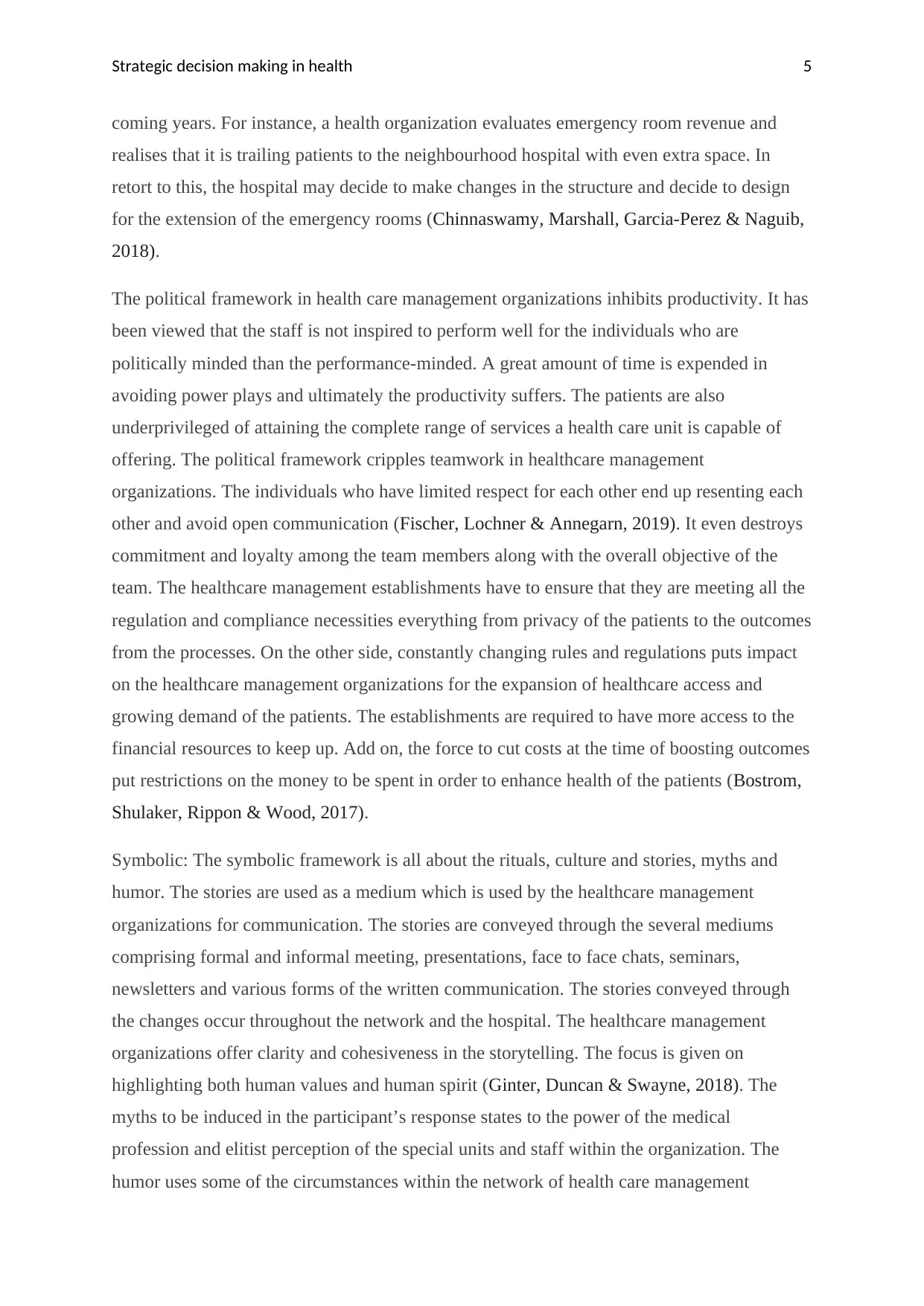
Strategic decision making in health 5
coming years. For instance, a health organization evaluates emergency room revenue and
realises that it is trailing patients to the neighbourhood hospital with even extra space. In
retort to this, the hospital may decide to make changes in the structure and decide to design
for the extension of the emergency rooms (Chinnaswamy, Marshall, Garcia-Perez & Naguib,
2018).
The political framework in health care management organizations inhibits productivity. It has
been viewed that the staff is not inspired to perform well for the individuals who are
politically minded than the performance-minded. A great amount of time is expended in
avoiding power plays and ultimately the productivity suffers. The patients are also
underprivileged of attaining the complete range of services a health care unit is capable of
offering. The political framework cripples teamwork in healthcare management
organizations. The individuals who have limited respect for each other end up resenting each
other and avoid open communication (Fischer, Lochner & Annegarn, 2019). It even destroys
commitment and loyalty among the team members along with the overall objective of the
team. The healthcare management establishments have to ensure that they are meeting all the
regulation and compliance necessities everything from privacy of the patients to the outcomes
from the processes. On the other side, constantly changing rules and regulations puts impact
on the healthcare management organizations for the expansion of healthcare access and
growing demand of the patients. The establishments are required to have more access to the
financial resources to keep up. Add on, the force to cut costs at the time of boosting outcomes
put restrictions on the money to be spent in order to enhance health of the patients (Bostrom,
Shulaker, Rippon & Wood, 2017).
Symbolic: The symbolic framework is all about the rituals, culture and stories, myths and
humor. The stories are used as a medium which is used by the healthcare management
organizations for communication. The stories are conveyed through the several mediums
comprising formal and informal meeting, presentations, face to face chats, seminars,
newsletters and various forms of the written communication. The stories conveyed through
the changes occur throughout the network and the hospital. The healthcare management
organizations offer clarity and cohesiveness in the storytelling. The focus is given on
highlighting both human values and human spirit (Ginter, Duncan & Swayne, 2018). The
myths to be induced in the participant’s response states to the power of the medical
profession and elitist perception of the special units and staff within the organization. The
humor uses some of the circumstances within the network of health care management
coming years. For instance, a health organization evaluates emergency room revenue and
realises that it is trailing patients to the neighbourhood hospital with even extra space. In
retort to this, the hospital may decide to make changes in the structure and decide to design
for the extension of the emergency rooms (Chinnaswamy, Marshall, Garcia-Perez & Naguib,
2018).
The political framework in health care management organizations inhibits productivity. It has
been viewed that the staff is not inspired to perform well for the individuals who are
politically minded than the performance-minded. A great amount of time is expended in
avoiding power plays and ultimately the productivity suffers. The patients are also
underprivileged of attaining the complete range of services a health care unit is capable of
offering. The political framework cripples teamwork in healthcare management
organizations. The individuals who have limited respect for each other end up resenting each
other and avoid open communication (Fischer, Lochner & Annegarn, 2019). It even destroys
commitment and loyalty among the team members along with the overall objective of the
team. The healthcare management establishments have to ensure that they are meeting all the
regulation and compliance necessities everything from privacy of the patients to the outcomes
from the processes. On the other side, constantly changing rules and regulations puts impact
on the healthcare management organizations for the expansion of healthcare access and
growing demand of the patients. The establishments are required to have more access to the
financial resources to keep up. Add on, the force to cut costs at the time of boosting outcomes
put restrictions on the money to be spent in order to enhance health of the patients (Bostrom,
Shulaker, Rippon & Wood, 2017).
Symbolic: The symbolic framework is all about the rituals, culture and stories, myths and
humor. The stories are used as a medium which is used by the healthcare management
organizations for communication. The stories are conveyed through the several mediums
comprising formal and informal meeting, presentations, face to face chats, seminars,
newsletters and various forms of the written communication. The stories conveyed through
the changes occur throughout the network and the hospital. The healthcare management
organizations offer clarity and cohesiveness in the storytelling. The focus is given on
highlighting both human values and human spirit (Ginter, Duncan & Swayne, 2018). The
myths to be induced in the participant’s response states to the power of the medical
profession and elitist perception of the special units and staff within the organization. The
humor uses some of the circumstances within the network of health care management
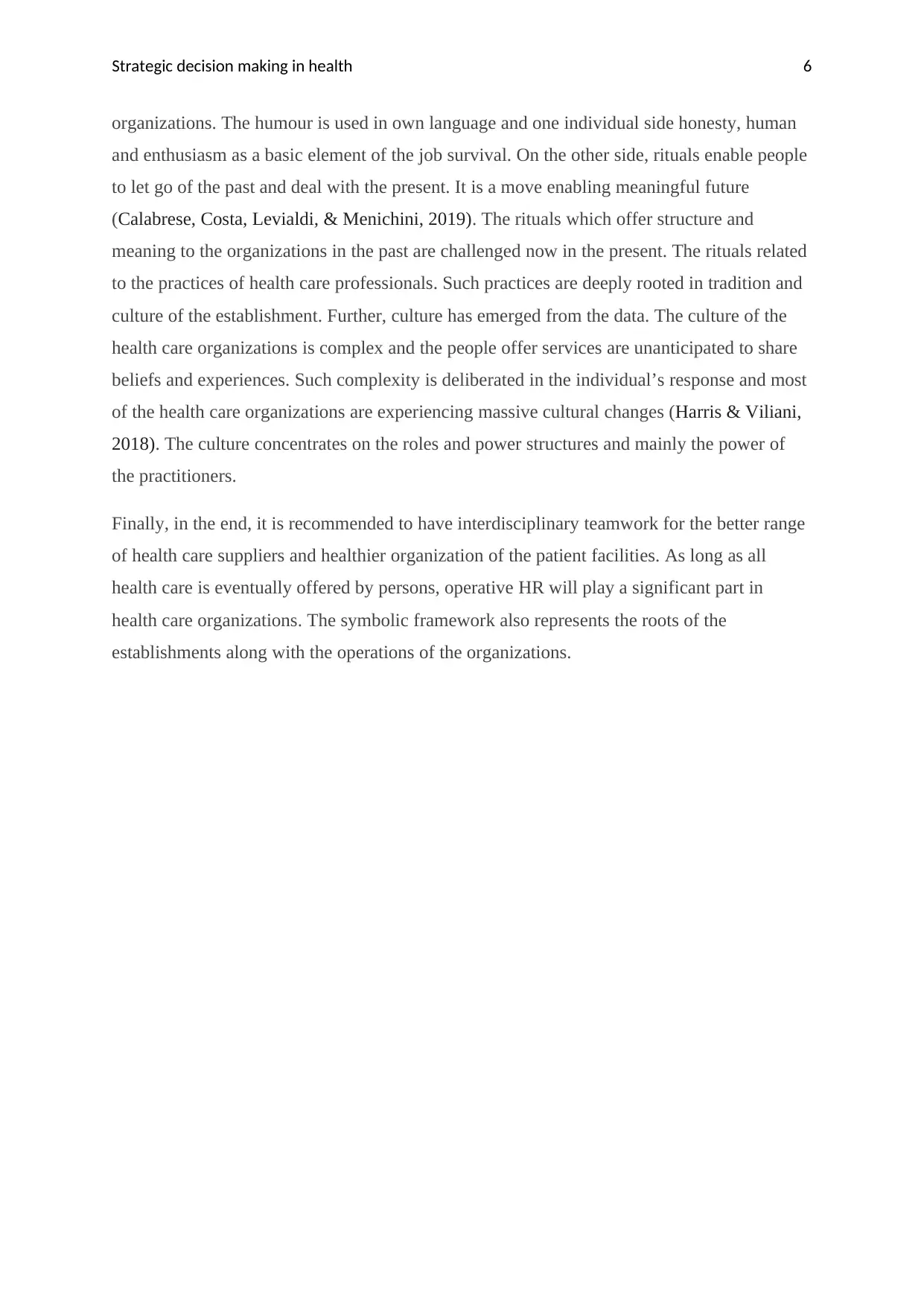
Strategic decision making in health 6
organizations. The humour is used in own language and one individual side honesty, human
and enthusiasm as a basic element of the job survival. On the other side, rituals enable people
to let go of the past and deal with the present. It is a move enabling meaningful future
(Calabrese, Costa, Levialdi, & Menichini, 2019). The rituals which offer structure and
meaning to the organizations in the past are challenged now in the present. The rituals related
to the practices of health care professionals. Such practices are deeply rooted in tradition and
culture of the establishment. Further, culture has emerged from the data. The culture of the
health care organizations is complex and the people offer services are unanticipated to share
beliefs and experiences. Such complexity is deliberated in the individual’s response and most
of the health care organizations are experiencing massive cultural changes (Harris & Viliani,
2018). The culture concentrates on the roles and power structures and mainly the power of
the practitioners.
Finally, in the end, it is recommended to have interdisciplinary teamwork for the better range
of health care suppliers and healthier organization of the patient facilities. As long as all
health care is eventually offered by persons, operative HR will play a significant part in
health care organizations. The symbolic framework also represents the roots of the
establishments along with the operations of the organizations.
organizations. The humour is used in own language and one individual side honesty, human
and enthusiasm as a basic element of the job survival. On the other side, rituals enable people
to let go of the past and deal with the present. It is a move enabling meaningful future
(Calabrese, Costa, Levialdi, & Menichini, 2019). The rituals which offer structure and
meaning to the organizations in the past are challenged now in the present. The rituals related
to the practices of health care professionals. Such practices are deeply rooted in tradition and
culture of the establishment. Further, culture has emerged from the data. The culture of the
health care organizations is complex and the people offer services are unanticipated to share
beliefs and experiences. Such complexity is deliberated in the individual’s response and most
of the health care organizations are experiencing massive cultural changes (Harris & Viliani,
2018). The culture concentrates on the roles and power structures and mainly the power of
the practitioners.
Finally, in the end, it is recommended to have interdisciplinary teamwork for the better range
of health care suppliers and healthier organization of the patient facilities. As long as all
health care is eventually offered by persons, operative HR will play a significant part in
health care organizations. The symbolic framework also represents the roots of the
establishments along with the operations of the organizations.
Paraphrase This Document
Need a fresh take? Get an instant paraphrase of this document with our AI Paraphraser
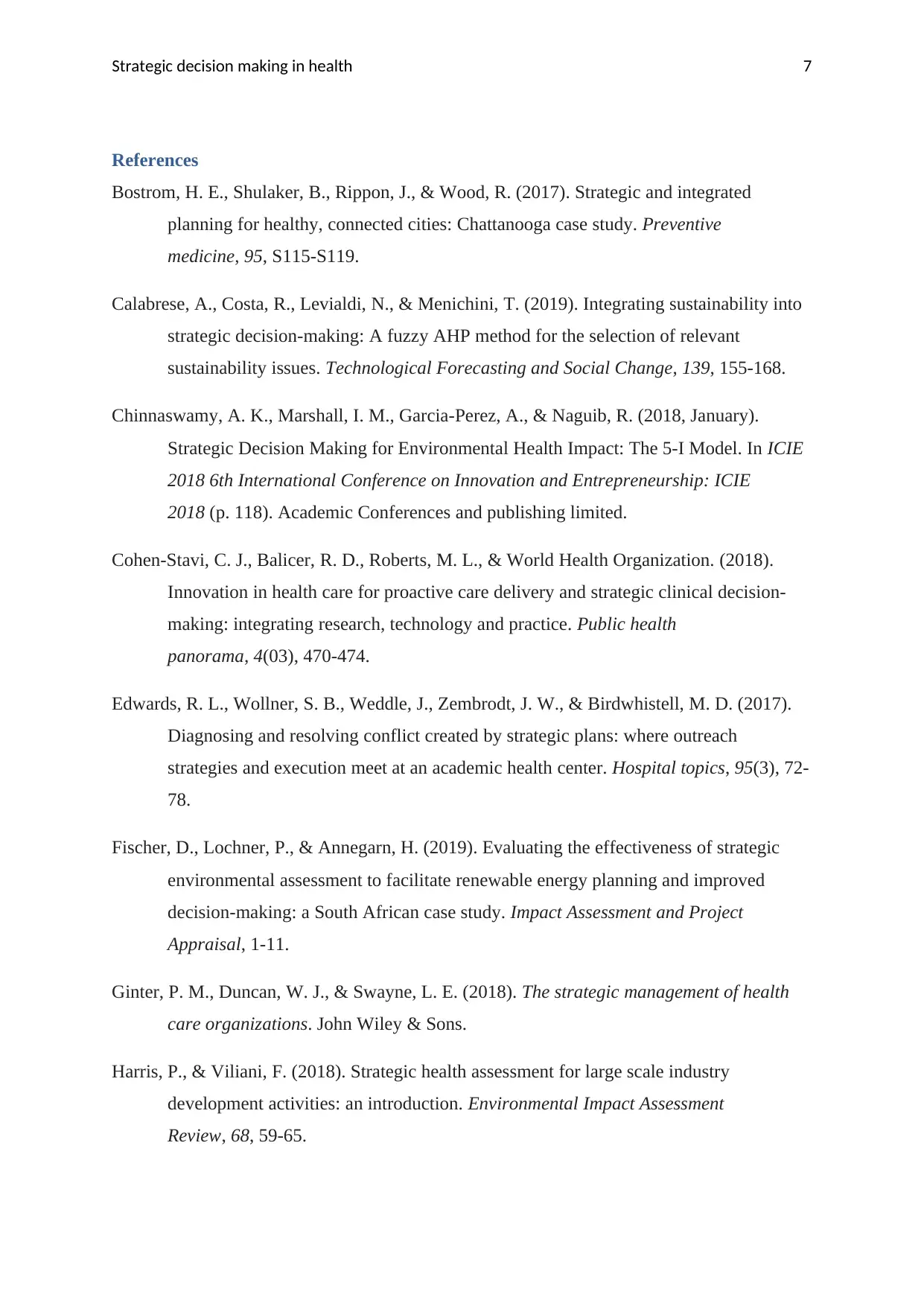
Strategic decision making in health 7
References
Bostrom, H. E., Shulaker, B., Rippon, J., & Wood, R. (2017). Strategic and integrated
planning for healthy, connected cities: Chattanooga case study. Preventive
medicine, 95, S115-S119.
Calabrese, A., Costa, R., Levialdi, N., & Menichini, T. (2019). Integrating sustainability into
strategic decision-making: A fuzzy AHP method for the selection of relevant
sustainability issues. Technological Forecasting and Social Change, 139, 155-168.
Chinnaswamy, A. K., Marshall, I. M., Garcia-Perez, A., & Naguib, R. (2018, January).
Strategic Decision Making for Environmental Health Impact: The 5-I Model. In ICIE
2018 6th International Conference on Innovation and Entrepreneurship: ICIE
2018 (p. 118). Academic Conferences and publishing limited.
Cohen-Stavi, C. J., Balicer, R. D., Roberts, M. L., & World Health Organization. (2018).
Innovation in health care for proactive care delivery and strategic clinical decision-
making: integrating research, technology and practice. Public health
panorama, 4(03), 470-474.
Edwards, R. L., Wollner, S. B., Weddle, J., Zembrodt, J. W., & Birdwhistell, M. D. (2017).
Diagnosing and resolving conflict created by strategic plans: where outreach
strategies and execution meet at an academic health center. Hospital topics, 95(3), 72-
78.
Fischer, D., Lochner, P., & Annegarn, H. (2019). Evaluating the effectiveness of strategic
environmental assessment to facilitate renewable energy planning and improved
decision-making: a South African case study. Impact Assessment and Project
Appraisal, 1-11.
Ginter, P. M., Duncan, W. J., & Swayne, L. E. (2018). The strategic management of health
care organizations. John Wiley & Sons.
Harris, P., & Viliani, F. (2018). Strategic health assessment for large scale industry
development activities: an introduction. Environmental Impact Assessment
Review, 68, 59-65.
References
Bostrom, H. E., Shulaker, B., Rippon, J., & Wood, R. (2017). Strategic and integrated
planning for healthy, connected cities: Chattanooga case study. Preventive
medicine, 95, S115-S119.
Calabrese, A., Costa, R., Levialdi, N., & Menichini, T. (2019). Integrating sustainability into
strategic decision-making: A fuzzy AHP method for the selection of relevant
sustainability issues. Technological Forecasting and Social Change, 139, 155-168.
Chinnaswamy, A. K., Marshall, I. M., Garcia-Perez, A., & Naguib, R. (2018, January).
Strategic Decision Making for Environmental Health Impact: The 5-I Model. In ICIE
2018 6th International Conference on Innovation and Entrepreneurship: ICIE
2018 (p. 118). Academic Conferences and publishing limited.
Cohen-Stavi, C. J., Balicer, R. D., Roberts, M. L., & World Health Organization. (2018).
Innovation in health care for proactive care delivery and strategic clinical decision-
making: integrating research, technology and practice. Public health
panorama, 4(03), 470-474.
Edwards, R. L., Wollner, S. B., Weddle, J., Zembrodt, J. W., & Birdwhistell, M. D. (2017).
Diagnosing and resolving conflict created by strategic plans: where outreach
strategies and execution meet at an academic health center. Hospital topics, 95(3), 72-
78.
Fischer, D., Lochner, P., & Annegarn, H. (2019). Evaluating the effectiveness of strategic
environmental assessment to facilitate renewable energy planning and improved
decision-making: a South African case study. Impact Assessment and Project
Appraisal, 1-11.
Ginter, P. M., Duncan, W. J., & Swayne, L. E. (2018). The strategic management of health
care organizations. John Wiley & Sons.
Harris, P., & Viliani, F. (2018). Strategic health assessment for large scale industry
development activities: an introduction. Environmental Impact Assessment
Review, 68, 59-65.
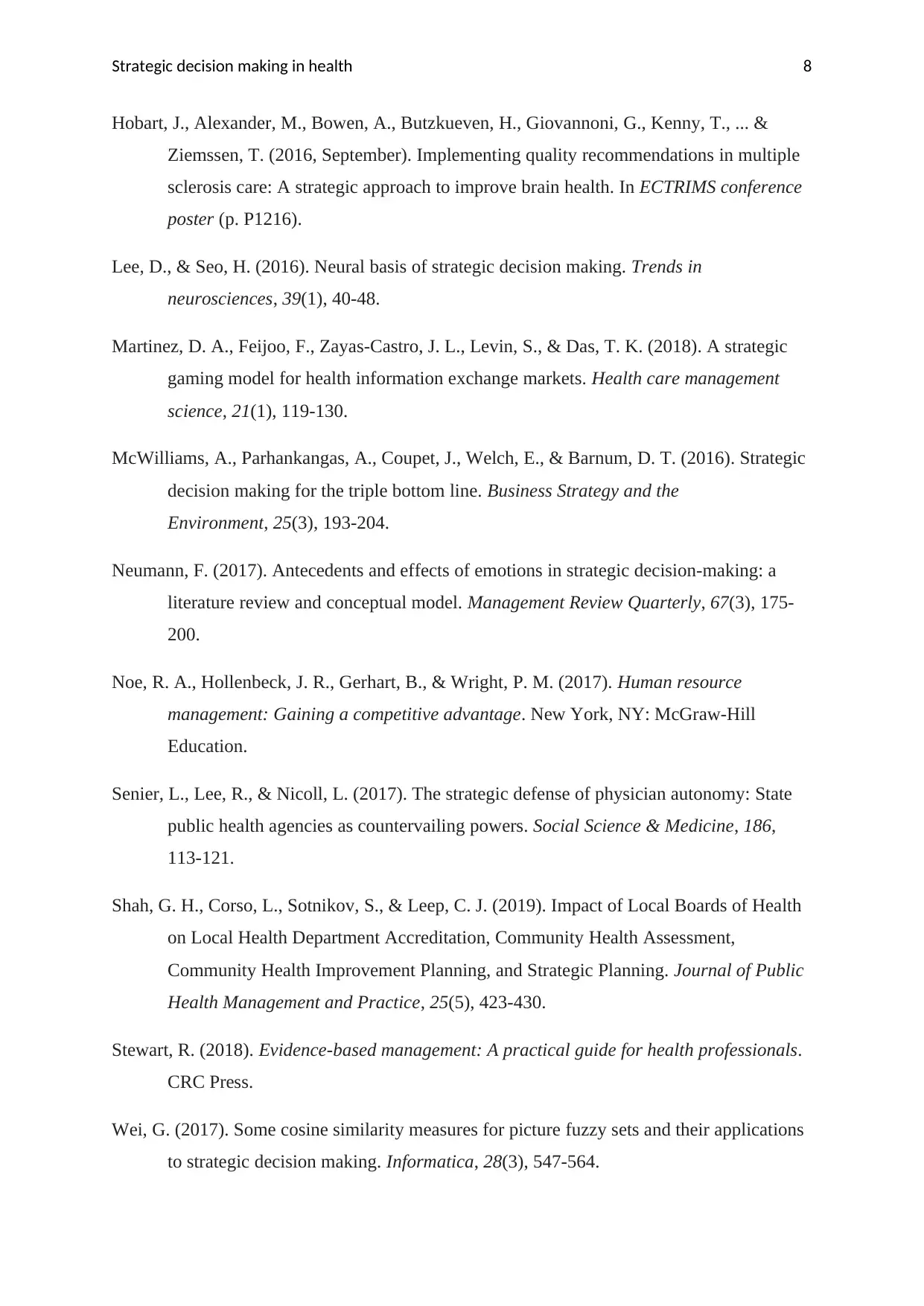
Strategic decision making in health 8
Hobart, J., Alexander, M., Bowen, A., Butzkueven, H., Giovannoni, G., Kenny, T., ... &
Ziemssen, T. (2016, September). Implementing quality recommendations in multiple
sclerosis care: A strategic approach to improve brain health. In ECTRIMS conference
poster (p. P1216).
Lee, D., & Seo, H. (2016). Neural basis of strategic decision making. Trends in
neurosciences, 39(1), 40-48.
Martinez, D. A., Feijoo, F., Zayas-Castro, J. L., Levin, S., & Das, T. K. (2018). A strategic
gaming model for health information exchange markets. Health care management
science, 21(1), 119-130.
McWilliams, A., Parhankangas, A., Coupet, J., Welch, E., & Barnum, D. T. (2016). Strategic
decision making for the triple bottom line. Business Strategy and the
Environment, 25(3), 193-204.
Neumann, F. (2017). Antecedents and effects of emotions in strategic decision-making: a
literature review and conceptual model. Management Review Quarterly, 67(3), 175-
200.
Noe, R. A., Hollenbeck, J. R., Gerhart, B., & Wright, P. M. (2017). Human resource
management: Gaining a competitive advantage. New York, NY: McGraw-Hill
Education.
Senier, L., Lee, R., & Nicoll, L. (2017). The strategic defense of physician autonomy: State
public health agencies as countervailing powers. Social Science & Medicine, 186,
113-121.
Shah, G. H., Corso, L., Sotnikov, S., & Leep, C. J. (2019). Impact of Local Boards of Health
on Local Health Department Accreditation, Community Health Assessment,
Community Health Improvement Planning, and Strategic Planning. Journal of Public
Health Management and Practice, 25(5), 423-430.
Stewart, R. (2018). Evidence-based management: A practical guide for health professionals.
CRC Press.
Wei, G. (2017). Some cosine similarity measures for picture fuzzy sets and their applications
to strategic decision making. Informatica, 28(3), 547-564.
Hobart, J., Alexander, M., Bowen, A., Butzkueven, H., Giovannoni, G., Kenny, T., ... &
Ziemssen, T. (2016, September). Implementing quality recommendations in multiple
sclerosis care: A strategic approach to improve brain health. In ECTRIMS conference
poster (p. P1216).
Lee, D., & Seo, H. (2016). Neural basis of strategic decision making. Trends in
neurosciences, 39(1), 40-48.
Martinez, D. A., Feijoo, F., Zayas-Castro, J. L., Levin, S., & Das, T. K. (2018). A strategic
gaming model for health information exchange markets. Health care management
science, 21(1), 119-130.
McWilliams, A., Parhankangas, A., Coupet, J., Welch, E., & Barnum, D. T. (2016). Strategic
decision making for the triple bottom line. Business Strategy and the
Environment, 25(3), 193-204.
Neumann, F. (2017). Antecedents and effects of emotions in strategic decision-making: a
literature review and conceptual model. Management Review Quarterly, 67(3), 175-
200.
Noe, R. A., Hollenbeck, J. R., Gerhart, B., & Wright, P. M. (2017). Human resource
management: Gaining a competitive advantage. New York, NY: McGraw-Hill
Education.
Senier, L., Lee, R., & Nicoll, L. (2017). The strategic defense of physician autonomy: State
public health agencies as countervailing powers. Social Science & Medicine, 186,
113-121.
Shah, G. H., Corso, L., Sotnikov, S., & Leep, C. J. (2019). Impact of Local Boards of Health
on Local Health Department Accreditation, Community Health Assessment,
Community Health Improvement Planning, and Strategic Planning. Journal of Public
Health Management and Practice, 25(5), 423-430.
Stewart, R. (2018). Evidence-based management: A practical guide for health professionals.
CRC Press.
Wei, G. (2017). Some cosine similarity measures for picture fuzzy sets and their applications
to strategic decision making. Informatica, 28(3), 547-564.
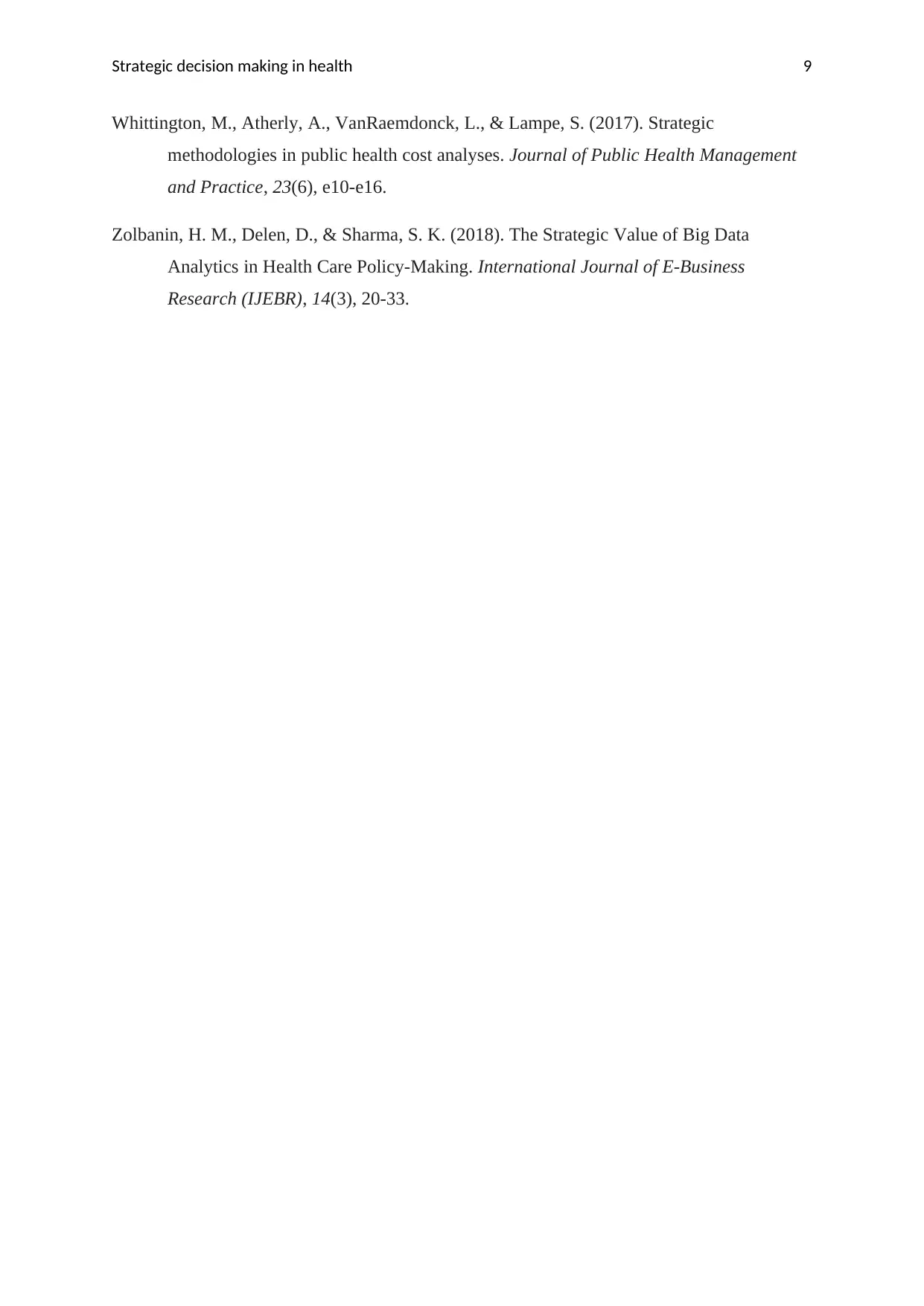
Strategic decision making in health 9
Whittington, M., Atherly, A., VanRaemdonck, L., & Lampe, S. (2017). Strategic
methodologies in public health cost analyses. Journal of Public Health Management
and Practice, 23(6), e10-e16.
Zolbanin, H. M., Delen, D., & Sharma, S. K. (2018). The Strategic Value of Big Data
Analytics in Health Care Policy-Making. International Journal of E-Business
Research (IJEBR), 14(3), 20-33.
Whittington, M., Atherly, A., VanRaemdonck, L., & Lampe, S. (2017). Strategic
methodologies in public health cost analyses. Journal of Public Health Management
and Practice, 23(6), e10-e16.
Zolbanin, H. M., Delen, D., & Sharma, S. K. (2018). The Strategic Value of Big Data
Analytics in Health Care Policy-Making. International Journal of E-Business
Research (IJEBR), 14(3), 20-33.
1 out of 10
Related Documents
Your All-in-One AI-Powered Toolkit for Academic Success.
+13062052269
info@desklib.com
Available 24*7 on WhatsApp / Email
![[object Object]](/_next/static/media/star-bottom.7253800d.svg)
Unlock your academic potential
© 2024 | Zucol Services PVT LTD | All rights reserved.





